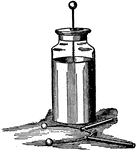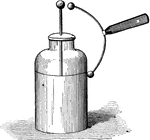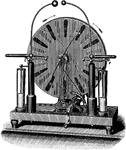Clipart tagged: ‘leyden’

Faraday Experiment
"Faraday used in his experiments two identical pieces of apparatus, which were vertually two spherical…

Leyden Jar
"The most common and, for many purposes, the most convenient form of condenser is the Leyden jar. This…

Lanes Jar
"D is a Leyden jar, fastened to a stand in such a way that its outer armature can be insulated or connected…
!["...or in a number of [leyden] jars connected together as a Leyden battery." -Atkinson 1903](https://etc.usf.edu/clipart/35700/35716/leybatt_35716_mth.gif)
Leyden Battery
"...or in a number of [leyden] jars connected together as a Leyden battery." -Atkinson 1903

Leyden Jar
"The Leyden jar and discharger. Its discovery is attributed to the attempt of Musschenbrock and his…

Leyden Jar
"...consists of a glass jar coated inside and outside with tinfoil, or some other thin sheet metal,…

Leyden Jar Connected to Terminals
"Then connect a Leyden jar to the terminals, as shown." -Avery 1895

Diagram of a Leyden jar
"The most common and, for many purposes, the most convenient form of condenser is the Leyden jar. This…

Whimhurst Machine
Two oppositely rotating glass discs connected to seperate Leyden jars generate electricity. -Atkinson…

Wimhurst Machine
"The Wimhurst machine is used to generate small amounts of static electricity which are then stored…
